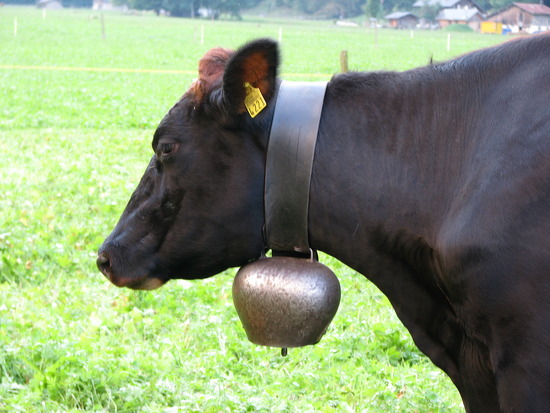Update(s): A hat tip to Andrew, who knew that "Silvester" refers to New Year's Day in much of central Europe. Now we just need to figure out what he might have been carrying in his left hand...*
And minutes later Chatterley found information on Silvesterklausen:
Silvesterklausen takes place in Appenzell, particularly in the communes of Urnäsch, Schönengrund, Schwellbrunn, Waldstatt, Herisau, Hundwil, Stein, and Teufen...You learn something every day. Thanks!!
The Chläuse (or Klause) are apparently based on a demonic cult that apparently merged with vegetation and fertility cults near Urnäsch, situated in the valley below Schwägalp.
p.s. - one vote for a "cow bell." Quick search yielded...
Ta-daaaa!!! Thank you, anon.
Update #2: Here are some ?final, definitive observations from another anon, who has first-hand experience with the events depicted:
To specify further: technically the boy's not carrying a cow bell but a trychel (Treichel in German, Treichle in Swiss German). Wikipedia puts the difference thus: "As opposed to regular cast metal bells, trychlen are made of hammered sheet metal. This results in a less clean, clanking sound, but at the same time results in a bell that is less heavy and thus easier to carry".Little kids roam the village from 0230 until 0530 in the winter. I am truly impressed.
...and Trycheln are less prone to breaking or getting cracks when shaken forcefully which is why my uncle who, since he was a farmer, lent me a bell for silvester each year wouldn't let me pick one of his beautiful (and more expensive) cast bells but a trychle. In our village in north eastern Switzerland we wouldn't wear masks and wouldn't consider ourselves "Silversterchläuse" as the boy in the photo. But all the children would meet on Silvester morning at 2.30 a.m. and - as one group - would roam the village for 3 hours, waking everybody up and wishing everybody a happy new year - and collecting sweets of course.
I think this post has changed enough to warrant bumping it back to the top of the column today.
Top photo found at the Fotografia photography blog, via Old Photos, Young Kids.


St. Silvester's Day (or just "Silvester") is a name for New Year's Day in much of central Europe.
ReplyDeletePreview! New Year's _Eve_.
ReplyDeleteI just looked it up on wikipedia, it's a kid dressed up for a custom called Silvesterklausen, which happens on New Years. People dress up in a certain way and wander through town, ringing bells and wishing everyone a happy new year.
ReplyDeletehttp://www.theswitzerlandtraveler.com/2008/01/appenzell-silvesterklausen/
The young lad is carrying a cow bell.
ReplyDeleteTo specify further: technically the boy's not carrying a cow bell but a trychel (Treichel in German, Treichle in swiss german). Wikipedia puts the difference thus: "As opposed to regular cast metal bells, trychlen are made of hammered sheet metal. This results in a less clean, clanking sound, but at the same time results in a bell that is less heavy and thus easier to carry".
ReplyDelete...and Trychlen are less prone to breaking or getting cracks when shaken forcefully which is why my uncle who, since he was a farmer, lent me a bell for silvester each year wouldn't let me pick one of his beautiful (and more expensive) cast bells but a trychle. In our village in north eastern Switzerland we wouldn't wear masks and wouldn't consider ourselves "Silversterchläuse" as the boy in the photo. But all the children would meet on Silvester morning at 2.30 a.m. and - as one group - would roam the village for 3 hours, waking everybody up and wishing everybody a happy new year - and collecting sweets of course.
p.s. love your blog!